|
|
|
|
|
|
As well as the ordinary shunting signals covered in Section 4 of this website, special shunting signals or indicators were developed for specific purposes such as hump shunting, propelling or loading/unloading. In some cases, standard signal types were used, but with special meanings attached to their indications.
At some goods sidings, especially those where private locomotives worked, a signal was provided to intimate that all shunting must cease, to allow a train to enter the sidings from the main line unhindered. On the Midland Railway, this signal took the form of a centrally pivoted crossbar, painted red on both sides. When the crossbar was visible (or a red light shown at night) [10.1], all shunting had to stop. When shunting was allowed, the crossbar was turned edge on and a green light was shown at night [10.2]. On the North Eastern Railway, a board signal was used for the same purpose. The sides of the board were notched [10.3] to indicate that it applied only to sidings. These boards were nicknamed 'cotton bobbins' because of their shape. When shunting was allowed, the board was turned edge on, similar to the crossbar signal [10.2].
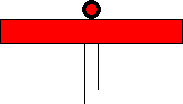 |
 |
 |
|
[10.1] Crossbar Signal ('on').
Area: Mid.R Usage: Unknown Status: Historical |
[10.2] Crossbar Signal ('off') / Board Signal ('off').
Area: Mid.R / NER Usage: Unknown Status: Historical |
[10.3] Board Signal ('on').
Area: NER Usage: Unknown Status: Historical |
|---|
'Stop shunting' signals also existed in semaphore form. On the Great Eastern Railway, the signal had the words "stop shunt" written on the arm [10.4]. When the arm was lowered to the 'off' position [10.5], shunting was permitted.
 |
 |
|
[10.4] "Stop Shunt" Signal ('on').
Area: GER Usage: Unknown Status: Historical |
[10.5] "Stop Shunt" Signal ('off').
Area: GER Usage: Unknown Status: Historical |
|---|
The North Eastern Railway had an extraordinary form of shunting signal with a semaphore arm that operated in four positions. The signal was operated by a shunter. When the arm was in the horizontal position [10.6], the meaning was "stop". The arm was raised through 45° from horizontal [10.7] for "forward", and lowered through 45° [10.8] for "backover" (i.e. "set back"). When the signal was not in use, the arm was hidden inside a slot in the post, and the light was obscured.
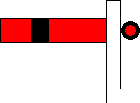 |
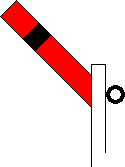 |
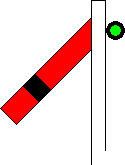 |
|
[10.6] Four-way Shunting Signal showing 'Stop'.
Area: NER Usage: Low Status: Historical |
[10.7] Four-way Shunting Signal showing 'Forward'.
Area: NER Usage: Low Status: Historical |
[10.8] Four-way Shunting Signal showing 'Backover'.
Area: NER Usage: Low Status: Historical |
|---|
In March 1929, the LNER opened Britain's first mechanised marshalling yard at Whitemoor, near March. Wagons were propelled from reception sidings over a hump, and moving along by gravity, they were directed into the various sorting sidings. A signal at the hump summit indicated to drivers the speed at which wagons should be propelled over the hump. At Whitemoor Up Yard, a conventional four-aspect colour light signal was used for this purpose, but the aspects gave different meanings from normal to drivers. A red aspect [10.9] carried the usual meaning, "stop". A single yellow aspect [10.10] meant "slow shunting speed", while a double yellow aspect [10.11] meant "quicker shunting speed". A green aspect [10.12] instructed the driver to "go forward smartly".
 |
 |
|
[10.9] Colour Light Signal showing Red Aspect.
Area: Various Usage: Medium Status: Obsolescent |
[10.10] Colour Light Signal showing Yellow Aspect.
Area: Various Usage: Medium Status: Obsolescent |
|---|---|
 |
 |
|
[10.11] Colour Light Signal showing Double Yellow Aspect.
Area: Whitemoor Usage: Low Status: Historical |
[10.12] Colour Light Signal showing Green Aspect.
Area: Various Usage: Medium Status: Obsolescent |
A hump signal generally had some form of shunting signal associated with it, to allow the train engine to run forward towards the hump and away from the reception sidings, usually onto a line that bypassed the hump.
The hump signal at Whitemoor Down Yard, which opened in January 1933, originally took the form of a position light signal. By exhibiting a line of three white lights inclined at different angles, it was able to show four indications. Three white lights horizontally displayed [10.13] meant "stop". Three white lights at 45° [10.14 & 10.15] meant either "slow shunting speed" or "quicker shunting speed", and three white lights vertically displayed [10.16] meant "go forward smartly".
 |
 |
|
[10.13] Position Light Signal showing horizontal indication (white lights).
Area: All Areas Usage: Medium Status: Historical |
[10.14] Position Light Signal showing diagonal indication (white lights).
Area: All Areas Usage: Medium Status: Historical |
|---|---|
 |
 |
|
[10.15] Position Light Signal showing diagonal indication (white lights).
Area: All Areas Usage: High Status: Current |
[10.16] Position Light Signal showing vertical indication (white lights).
Area: All Areas Usage: High Status: Current |
The mechanisation of Toton Down Yard by the LMS in May 1939 included hump signals of the position light type, but these could display just three indications. Three white lights horizontally displayed (see [10.13]) meant "stop humping", three white lights at 45° (see [10.15]) meant "hump slow", and three white lights vertically displayed (see [10.16]) meant "hump normal". To ensure that drivers of the hump locomotive had good visibility of the instructions given by the main hump signal, a series of additional hump signals was installed along each of the arrival lines to repeat its indication, and these were located in such a way that the driver always had a clear view of at least one of them. The hump signals were only illuminated while a humping movement was being made. The same type of position light hump signals were provided at Toton Up Yard when it was mechanised in September 1950, and these became known as 'Toton signals'.
In the absence of numerous repeater signals, neither colour light signals nor position light signals were ideally suited for use as hump signals, because their beam could not be focussed towards every reception siding from which a train may approach. By 1942, the position light hump signal (see [10.13 - 10.16]) at Whitemoor Down Yard was replaced by a three-position lower quadrant semaphore signal, which gave better results. The arm in the horizontal position [10.17] meant "stop". The arm lowered through 45° from horizontal [10.18] was an instruction to drivers to propel towards the hump at normal shunting speed, and through 90° [10.19] meant "go forward smartly".
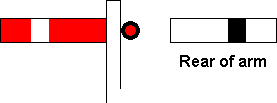 |
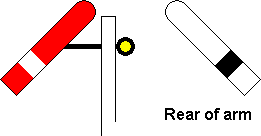 |
 |
|
[10.17] Three-position Semaphore Hump Signal showing 'Stop'.
Area: Whitemoor / Ripple Lane Usage: Low Status: Historical |
[10.18] Three-position Semaphore Hump Signal showing 'Go Forward at Normal Shunting Speed'.
Area: Whitemoor Down Yard Usage: Low Status: Historical |
[10.19] Three-position Semaphore Hump Signal showing 'Go Forward Smartly'.
Area: Whitemoor Down Yard Usage: Low Status: Historical |
|---|
In 1945, the colour light hump signal (see [10.9 - 10.12]) at Whitemoor Up Yard was replaced by two three-position upper quadrant semaphore signals situated on opposite sides of the line. These three-position signals were of the same type normally used as main signals (see [2.83 & 2.84]), but their indications gave different meanings from normal to drivers. The arm in the horizontal position (see [10.17]) conveyed the usual meaning, "stop". The arm raised through 45° from horizontal [10.20] was an instruction to drivers to propel towards the hump at normal shunting speed, and through 90° [10.21] meant "go forward smartly". A similar three-position semaphore hump signal was provided at Ripple Lane in 1961.
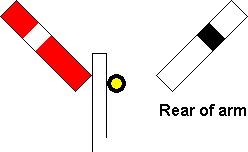 |
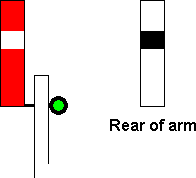 |
|
[10.20] Three-position Semaphore Hump Signal showing 'Go Forward at Normal Shunting Speed'.
Area: Whitemoor Up Yard / Ripple Lane Usage: Low Status: Historical |
[10.21] Three-position Semaphore Hump Signal showing 'Go Forward Smartly'.
Area: Whitemoor Up Yard / Ripple Lane Usage: Low Status: Historical |
|---|
|
|